Though we might be barely three hundred metres from shore, there’s a real sense of adventure as my son and I, with guide Dat Ki, paddle slowly in a wooden canoe across the calm brown waters of a lake within Cat Tien National Park, south Vietnam. There are no other boats out; around us, the grassy shores are backed by dense green rainforest.
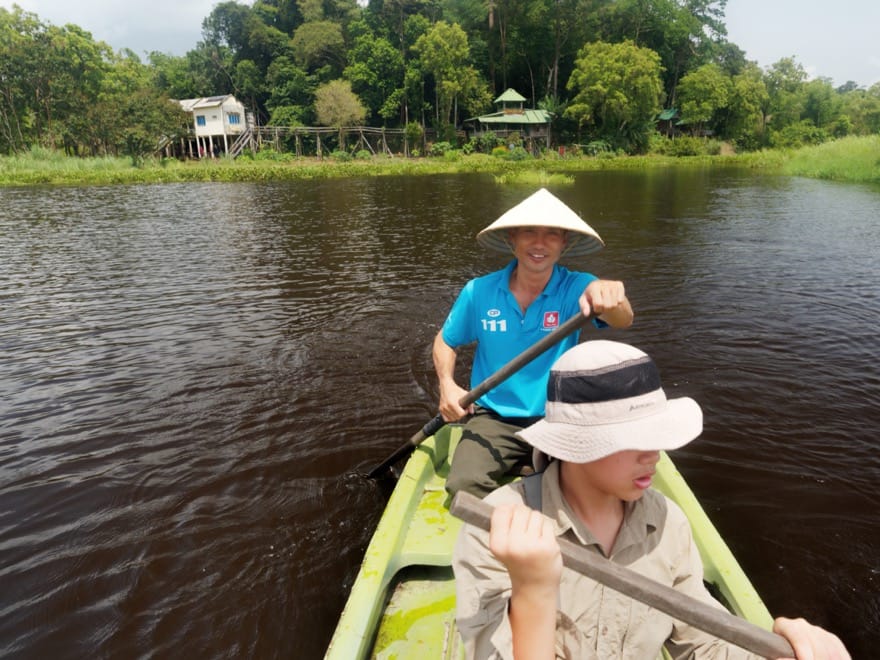
Scanning the shorelines, there’s not even a glimpse of the birds such as storks and herons, nor water buffalo, which we hoped for. It seems there may be no sizeable animals for miles around, yet I know this is called Crocodile Lake for a reason – as it’s inhabited by Siamese crocodiles. Yes, this means they belong to a relatively small crocodile species, rarely growing to over three metres long. But even so, some might be lurking close by, watching … waiting.
Dat is concerned by the freshening breeze, and we find the way back to a park rangers’ station has been blocked by a drifting raft of water hyacinths, which he slowly pulls us through through.
The rangers’ station features a rather rickety looking, two-storey wooden building, with benches by wide openings, where visitors can sit and watch for wildlife. Earlier, we’d seen a crocodile from here – it was mostly submerged, leaving only the head visible. But now, our attention is drawn to an approaching rainstorm, which blots out the far shore of the lake, then advances towards us, bringing a torrential downpour.
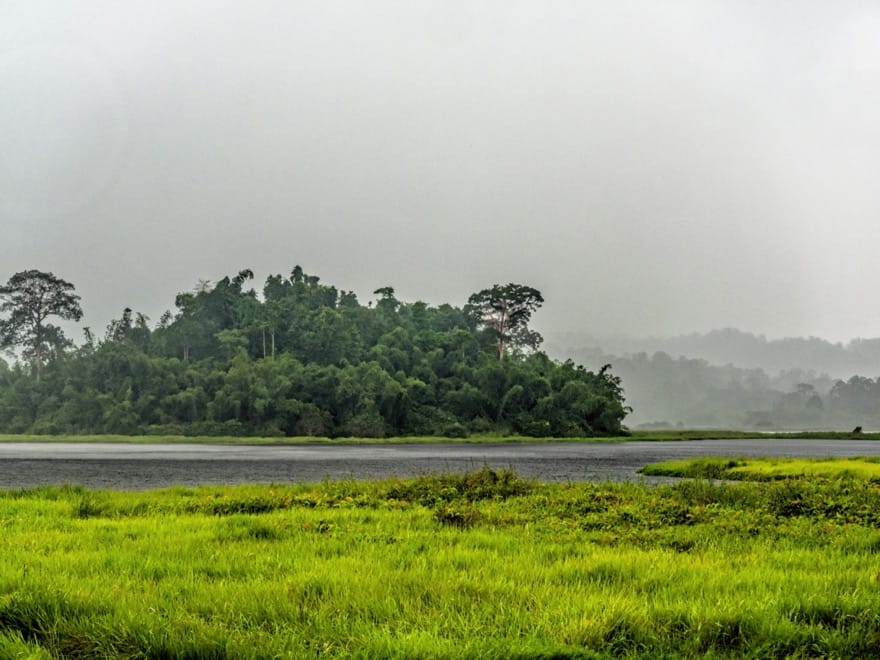
Cat Tien – the world’s 411th biosphere reserve
The deluge is no surprise, given we are visiting a rainforest in the rainy season. The abundant rain plus tropical warmth and sunshine spur the growth of lush forest that supports a rich diversity of wildlife, and is protected by the Cat Tien National Park. In 2001, this was recognised by UNESCO as the world’s 411th biosphere reserve, encompassing a lowland region with an area of 720 square kilometres – around two-thirds the size of Hong Kong. According to the park’s website, 351 species of birds have been found here, along with over 120 reptile and amphibian species, and 105 species of mammals, which include Asian elephants, wild cattle, deer, mongooses, squirrels, pangolins and clouded leopards.
At the turn of the century, Cat Tien was one of only two places in the world where Javan rhinos survived, the other being a national park in Indonesia. But an article on the BBC website relates that in April 2010 the park’s last Javan rhino, a female, was found dead, after succumbing to to a leg wound from a poacher’s bullet. Her horn had been cut off, surely to be sold into the black market for rhino horn that’s falsely touted as a cure for diseases including cancer.
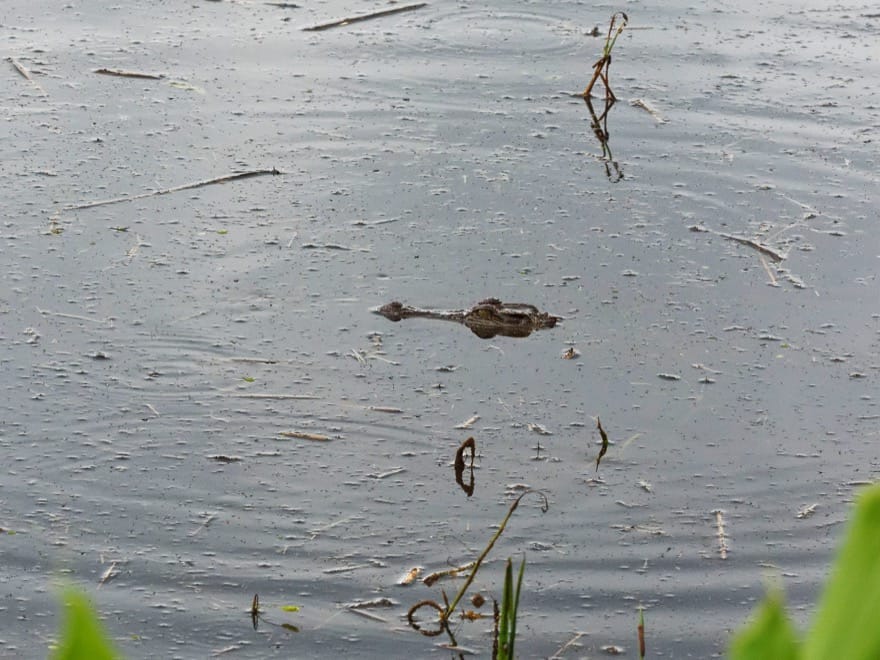
Other animals have also declined or vanished. “That’s Tiger Hill,” Dat tells us, pointing to a low hill across the lake. “There used to be tigers here, but they’re gone now.” One reason, he says, is that after the Vietnam War ended in 1975, guns and ammunition abounded, leading to rampant poaching. The Siamese crocodiles were wiped out as well, but 60 were released here in the early 2000s, and now this lake hosts an important population of this critically endangered species, which is included in the IUCN red list, with perhaps less than 1000 individuals worldwide.
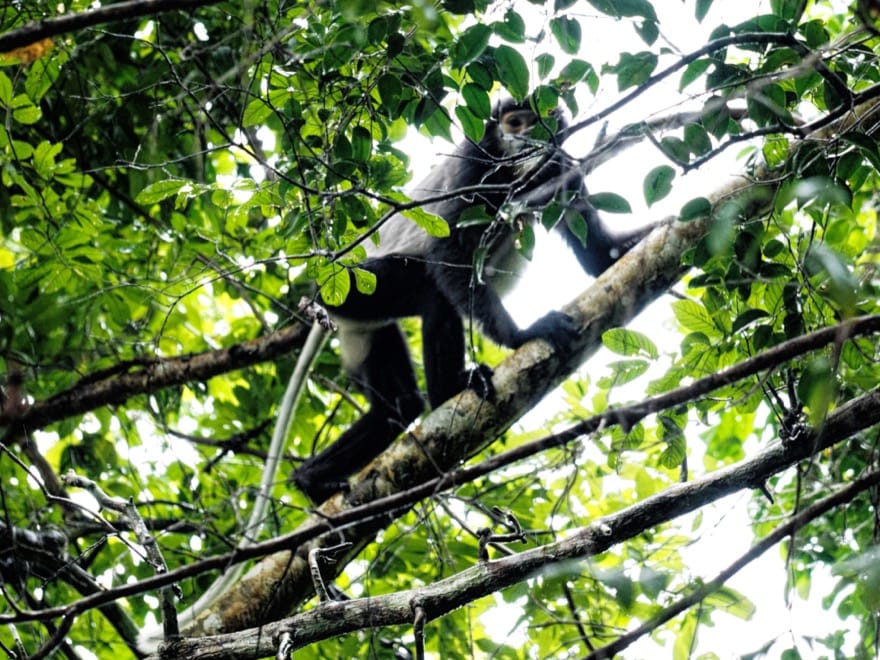
We start heading back along the narrow path we walked to get here through the jungle. Rainwater cascades from the tree canopy above, drips from bamboo and bushes. We pass an imposing tung tree, with buttress roots supporting a trunk looking as wide as a minibus. Dat halts to point out a monkey on branches maybe 30 metres above us. It’s a black-shanked douc langur, a handsome, black and white monkey, with white back, belly and face, and a long white tail. For a few seconds, it pauses to watch us, then scampers off, into the greenery.
The rain halts by the time we reach the forest road, which is here just a dirt track. Soon, a national park vehicle arrives to collect us. It’s like a safari jeep, with an open top where you can sit and hang on to cross bars. Some evenings, Dat takes visitors out in this to look for deer and other nocturnal mammals. We bounce back towards park headquarters, sloshing along muddy stretches of road.
At the headquarters, there’s a cluster of rather solemn looking two-storey buildings, housing staff including researchers. Bicycles can be hired here – we try one day, and my son delights in hurtling into the ruts and puddles along the road towards Crocodile Lake, though we find it’s much easier riding in the opposite, northwards direction. There’s also a small sanctuary for mammals including bears and gibbons. The latter attract a wild gibbon one morning; he sits high in a tree, golden-orange fur prominent amidst the greenery, and sings the loud, ululating, whooping song that’s like the signature theme of Southeast Asia’s rainforests.
While there is simple accommodation here, we’re staying across the Dong Nai River, which marks the eastern boundary of the park. To cross it, we must take a simple ferry from beside the headquarters. There’s no ferry pier; we wait beside a narrow road that vanishes into the water as if covered by a high tide – with the river perhaps six metres deeper than during the dry season.
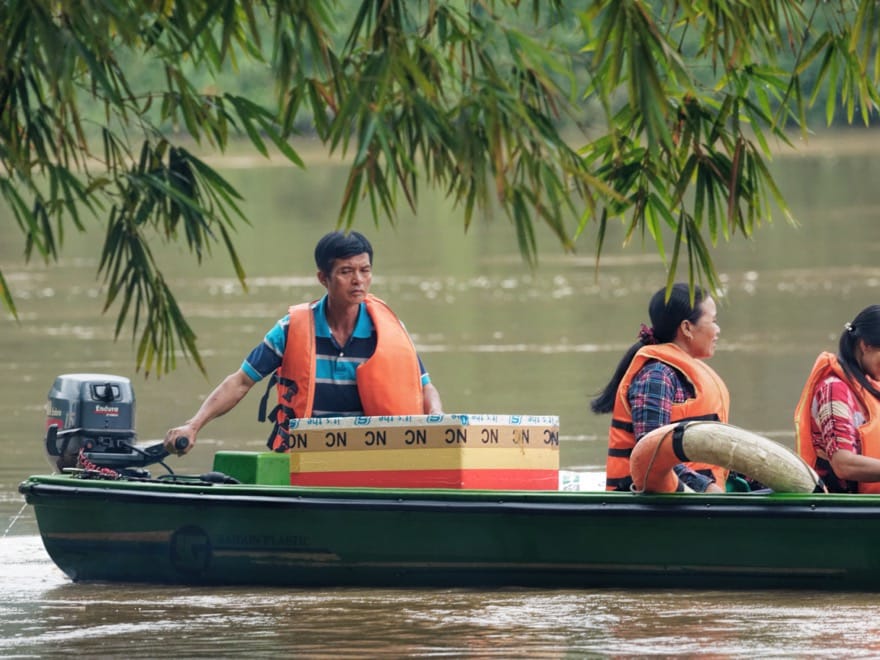
The ferry is like a large motorised canoe, seating perhaps ten at most, and takes us across the swirling waters of the river to the opposite shore, around 120 metres away.
Ho Chi Minh – relics of French colonial times, and war
The Dong Nai River is a major water source for Ho Chi Minh City, roughly 160 kilometres to the southwest. We’ve already spent a couple of days exploring the city, finding it like an expansive town with a relatively chilled vibe, and good for walking around – apart from occasions we had to cross roads while dodging through streams of scooters.
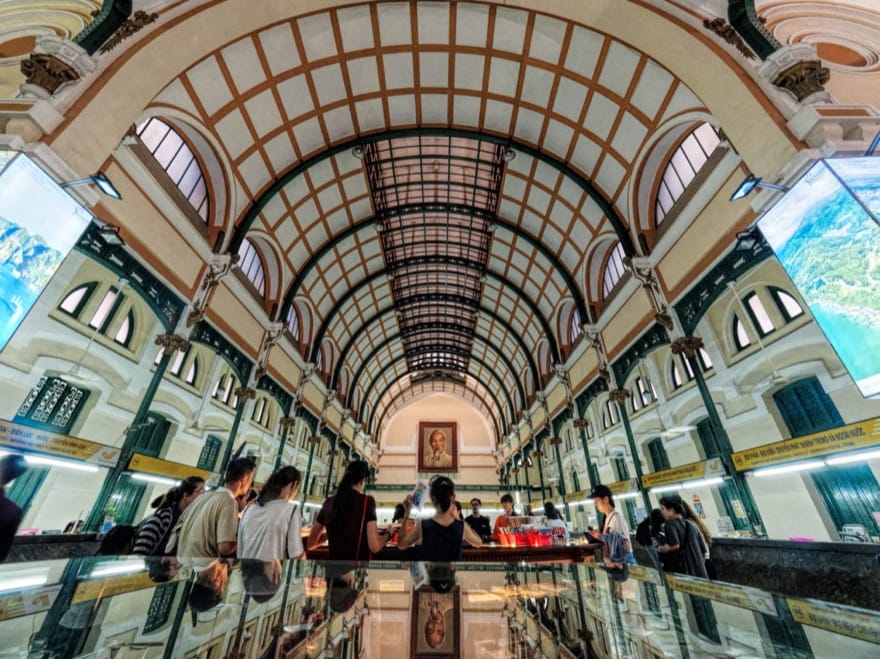
Until 1976, Ho Chi Minh City was officially known as Saigon, a name that’s still commonly used by many Vietnamese people. We’ve found it especially fascinating for relics of history, like two grand buildings from French colonial times – a cathedral and a post office, which were built in the late 19th century. The Notre Dame Cathedral impresses with its two bell towers soaring to a height of 58 metres (190 feet). Just across a road from it, the post office reminds me of a Victorian-era British railway station, including for its central hallway with a curved arched roof maybe three storeys above counters that still sell stamps, along with souvenirs for tourists.
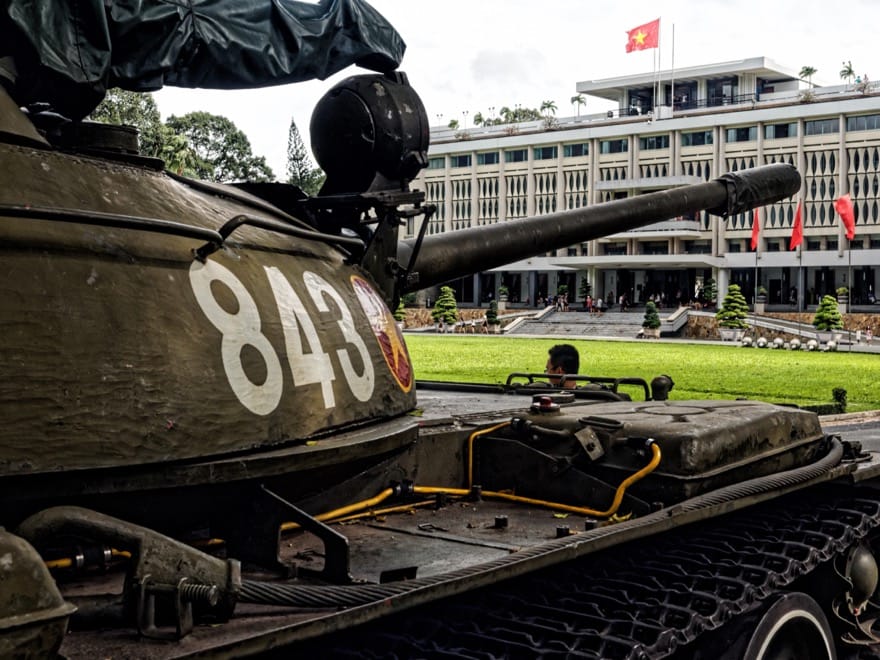
There’s a palace here, too, but it’s an austere one, resembling a squat government office block set in its own grounds. This is Reunification Palace – or Independence Palace, and was built during the Vietnam War, becoming the headquarters of South Vietnam’s president, Nguyễn Văn Thiệu. On 30 April, the war effectively ended as a North Vietnamese tank crashed through the palace gate.
Over, but not forgotten, and with lasting impacts. At the War Remnants Museum, there’s a collection of American military vehicles, plus harrowing photos of and information on atrocities committed by American and South Vietnamese troups. Visitors read, look, move on to next exhibits while barely saying a word.
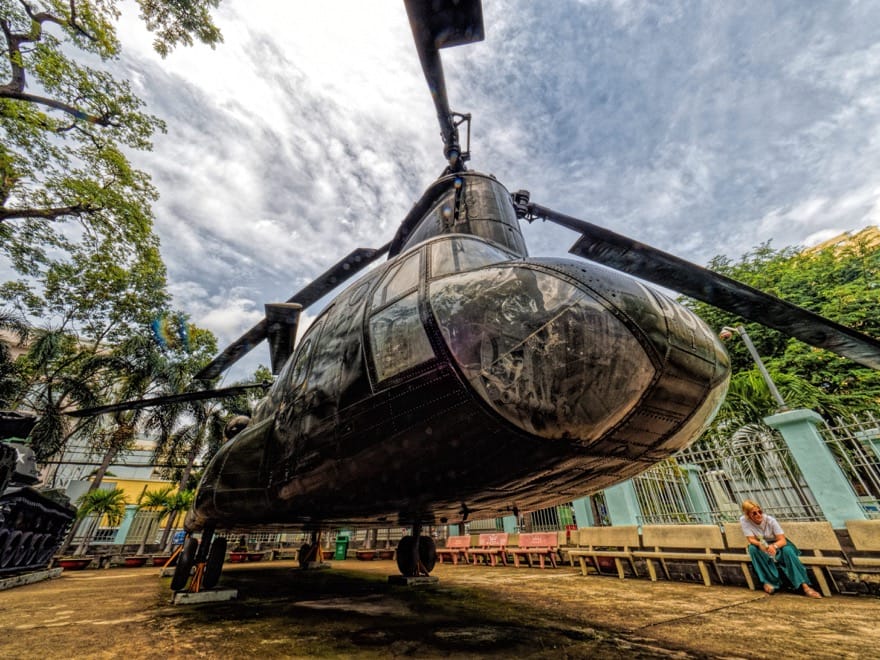
For me, growing up in the UK, the Vietnam War was something terrible, yet distant. But in Cat Tien, we learn more of its reality, as Dat Ki briefly tells us that his parents settled in the area after coming south during the war, as members of North Vietnamese forces pursing the South Vietnamese and Americans. On this wet afternoon in the forest, surrounded by trees that are lush again, recovered from defoliants sprayed by the Americans, I reflect how Dat Ki’s parents were on a very different side, with “the enemy”. Yet now, my son, Dat and I talk as friends, drawn together by a love of wild places and their wildlife.
Planning a trip to Cat Tien National Park?
Cat Tien National Park is three to four hours by road from Ho Chi Minh City. If you first book accommodation at the park, they should be able to arrange a car to take you.
For the best forest experience, including being able to search for wildlife at dawn and after dark, consider staying at the Forest Floor Lodge, which is within the national park, beside Dong Nai River. There is also accommodation across the river from the park headquarters, such as the Cat Tien Jungle Lodge, which is comfortable, with an outdoor pool just above the river (we stayed here).
The Cat Tien National Park website has information, especially on the wildlife. The rainy season is from May to October, peaking from July to September.

























